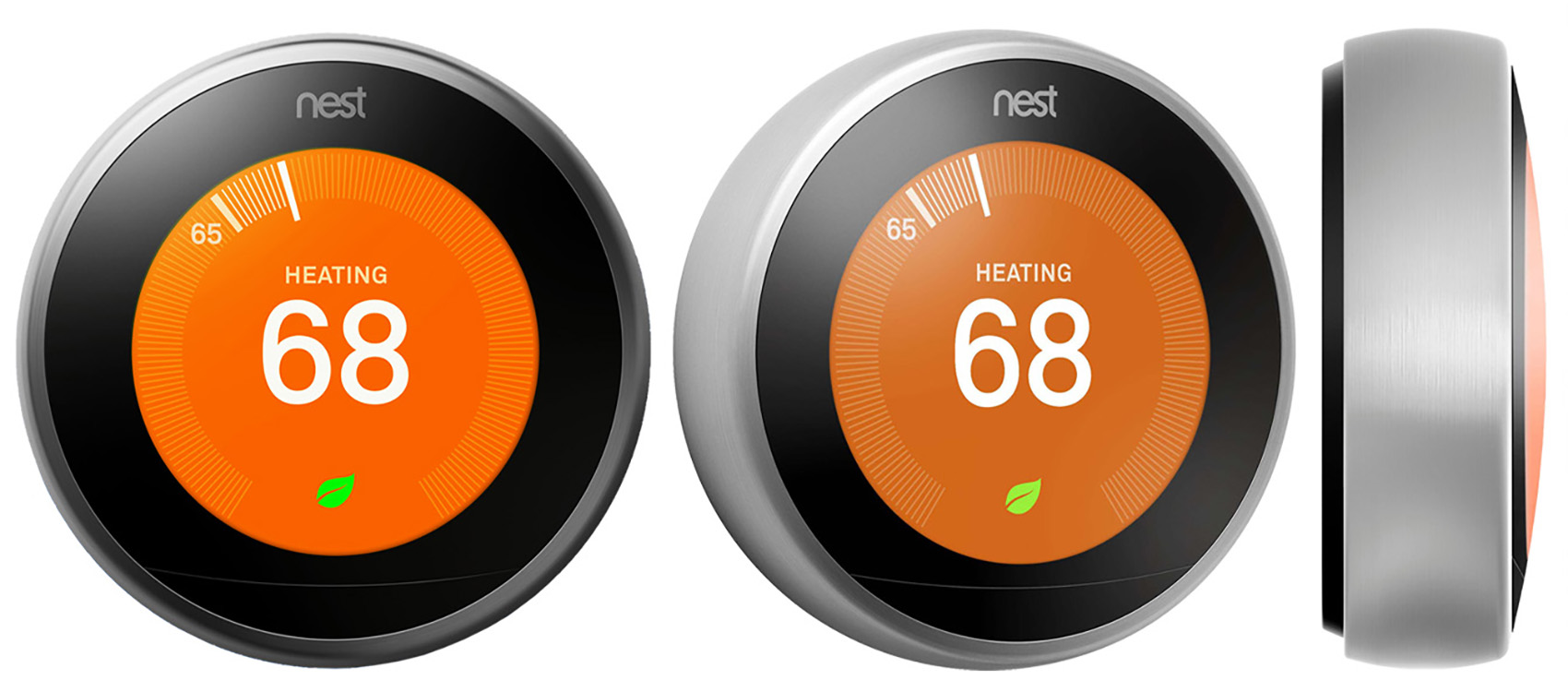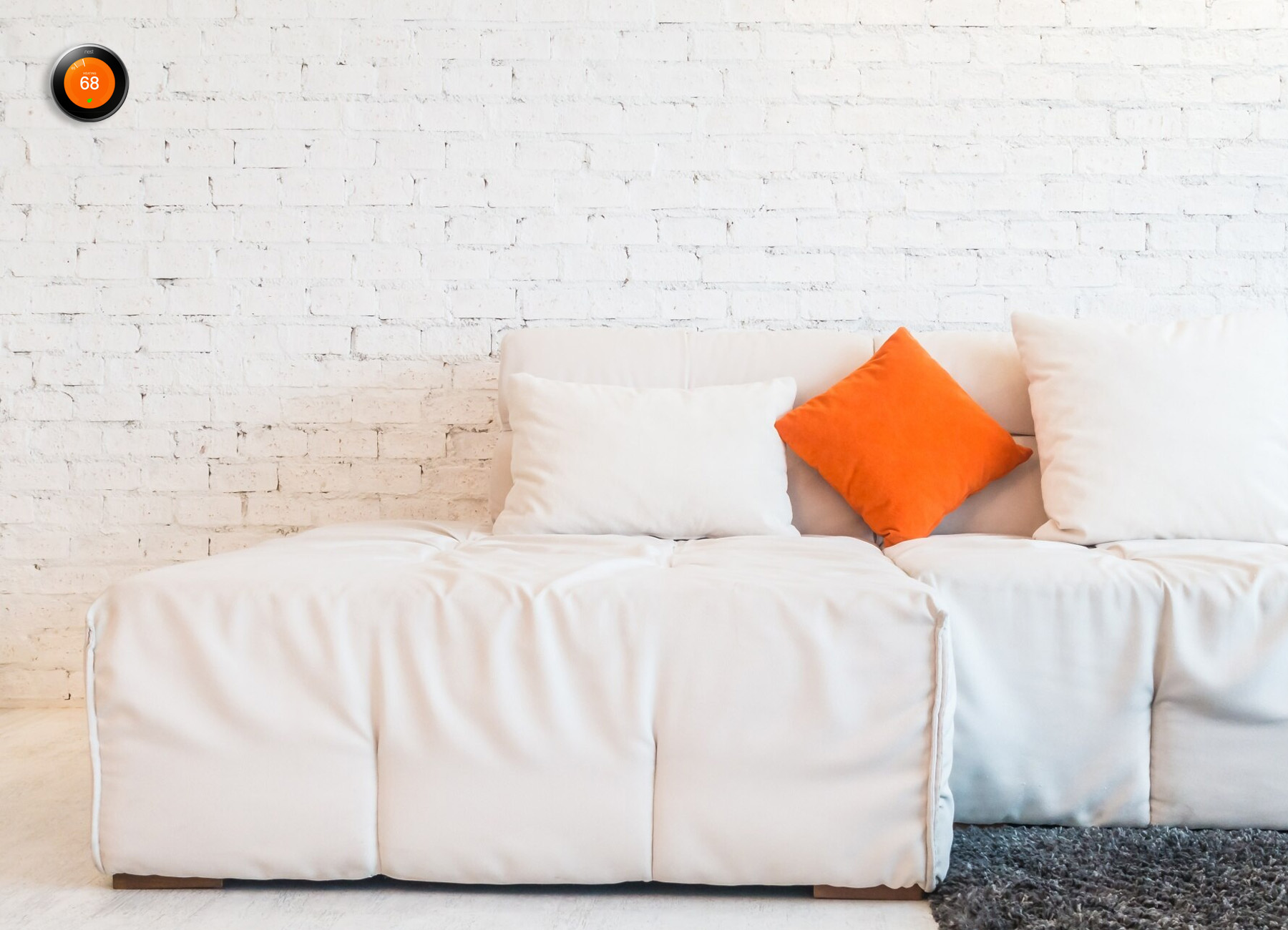Does Nest Thermostat Work Without Power?
Nest Thermostat will work without power for a short time because they all have a battery backup. Every Nest thermostat is primarily powered by a low-voltage wire running to the HVAC system. When power goes out, the Nest runs on its battery backup. What model Nest you have dictate what type of backup battery it uses. Nest Learning Thermostats use a removable and rechargeable lithium-ion battery while regular Nest Thermostats have 2 AAA batteries. Some of the newer Nest Thermostat models like Nest Thermostat E and Nest Thermostat 3rd Gen do not have a user-replaceable battery. Instead, the battery is permanent and built into the device.
Once the Nest switches to its battery backup, it only has enough power to run for a few hours. As battery power drains, some functions will become unusable and the entire thermostat will eventually shut down. How long this takes depends on how much you’re using the thermostat.
When power starts to get low, the Nest will automatically make changes to its programming to keep your HVAC running as long as possible. Non-essential functions like smartphone capability, WiFi and software updates will be temporarily shut off to preserve battery life. During this time, anything you want to adjust will need to be done at the thermostat.
When power returns, the Nest will slowly get back to functioning normally. This usually takes about an hour to complete.
Without power from your HVAC unit, a Nest Thermostat will have limited functionality. But it will still serve its primary function which is to control the HVAC system. For shorter power outages, this can be very helpful, but if you’re out of power for more than a few hours the Nest will eventually shut down and you won’t be able to control your HVAC.
What Does A Nest Thermostat Battery Do?
Nest Thermostats primarily run on power supplied by the HVAC system, but they also have a battery backup in case the power goes out. Regular Nest Thermostats have 2 AAA batteries as a backup. But Nest Learning Thermostats have a built in rechargeable Lithium-Ion battery backup. The role of a battery backup is to ensure the thermostat can continue to function if the main power source is lost.
- The Lithium-Ion battery is designed to last for several hours and will automatically charge itself when the main power is restored.
- Lithium-Ion battery power can be checked on the thermostat screen or through the Nest app. If the battery level is low, it will alert you to charge it.
- AAA batteries are not recharged by the Nest. However, you can use rechargeable AAA batteries in a Nest.
Replacing the Lithium-Ion battery is easy to do. To access it, simply remove the thermostat’s faceplate.
- The battery backup used by Nest Learning Thermostat is a standard CR123A lithium-ion battery.
Some of the newer Nest thermostat models like Nest Thermostat E and Nest Thermostat 3rd Gen do not have a user-replaceable battery. The battery is permanent and built into the device.
All Nest thermostats are designed to work with your HVAC system. They require a hard-wire connection to your home’s HVAC system as a primary power source. The battery is only a backup power source and is not intended to be a primary power source for the thermostat.
If your home loses power, the Nest Thermostat will automatically switch to battery power. However, if your HVAC system is also not working, your Nest Thermostat will not be able to control the temperature. In this case the battery power is only used to retain the thermostat’s settings and schedule until power is restored.
How Long Does A Nest Thermostat Last Without Power?
Google Nest Thermostats run on power supplied by the HVAC system with a battery backup in case the power goes out. Regular Nest Thermostats have 2 AAA batteries while Nest Learning Thermostats use a built in rechargeable Lithium-Ion battery. If the Nest’s primary power source goes down, its battery backup will power the Thermostat for a short time. This ensures the thermostat can continue to control your HVAC system when the power is out.
- A Nest battery backup will power the thermostat for about 10 hours of continuous use when fully charged. However, your batteries may not be totally full when the power goes out. The amount of power in the batteries and how often you use the thermostat will effect how long the batteries last in a power outage.
- As the batteries are drained, your Nest will start to turn off non essential functions like WiFi and smartphone connectivity. This is to keep its primary functions, like controlling the HVAC system, working as long as possible.
- If the HVAC in your home is electric, power is required to run the system. In this case you’re Nest battery backup won’t be of much use because the HVAC system will be offline.
- Nest Thermostat comes with low-voltage protection which enables the usage of a generator. If you have a generator and the power goes out, the generator will power the Nest instead of the backup batteries. Your backup batteries won’t turn on unless the generator also goes offline.
If you want your Nest to work as long as possible when the power goes out, use high quality AAA batteries. Brands like Energizer or Duracell contain more power and last longer than cheaper no name brands.
Do You Have To Charge The Nest Thermostat’s Internal Battery?
No, there is no need to charge your Nest Thermostat internal battery. Nest Thermostats are primarily powered by the HVAC system via a low voltage wire. The battery backup only turns on when the primary power source goes down. While the primary power is on, it keeps the batteries charged. There’s no need to charge the batteries outside of the Nest.
A Nest Thermostat’s Lithium-Ion battery automatically recharges as soon as the main power is restored. While power is on, it keeps the battery fully charged and ready in the event power goes out.
Although charging a Nest’s internal lithium-ion battery is not necessary, there are cases when the battery level may get low. This can happen if there’s a problem with the low voltage wire and not your power. The Nest will send an alert to your smartphone telling you the battery is low. Or you can check the Nest’s battery level at the thermostat or in the Nest app.
- If you get warnings on your smartphone about low battery problems you should check the wire connection. Nest Thermostats are powered by a low-voltage cable connected to the HVAC system. If there’s a bad connection or wire, your Nest may not be receiving enough power for it to function properly.
- If your Nest is consistently having power and low battery issues, call a professional to check the wiring connections.
When the battery level runs low it’s easy to recharge the battery manually if you have to. Simply connect your Nest to a USB port. In about 2 hours the battery will be fully charged.
Why Is My Nest Thermostat Draining The Batteries?
Voc, Vin, and Iin measure the electrical current sent to your thermostat by the system wires. Nest Thermostats require a certain amount of power to function properly. If enough power isn’t being sent by the system wiring, your nest will draw power from the batteries. This can cause low power notifications, drained and dead batteries or connectivity problems.
Nest Thermostats use very little power, averaging just 6V to 7V when the system is running. That equates to less than 1 kWh/month on average.
Below are the ranges that the Voc, Vin and Iin should stay in during normal operation. There are different Vin and lin values if you have a common or C wire in your thermostat:
If there isn’t a C wire in your thermostat:
- Voc: 29 to 42V
- Vin:
- 29 to 42V when your system is not running
- 6 to 7V when your system is running
- Iin: 20 to 40 mA
If there is a C wire in your thermostat:
- Voc: 29 to 42V
- Vin: 29 to 42V
- Iin: 100 or 200 mA
When your Nest batteries are draining, it’s usually a bad wire connection or a faulty wire. But to find out for sure you’ll have to do some troubleshooting.
Troubleshooting power issues:
- If your Nest Thermostat won’t turn on and is unresponsive, or you see a blinking red light at the top of the Thermostat’s screen, it may not be getting enough power to charge its battery.
- There’s a slight possibility that your thermostat is faulty.
- The battery could be bad.
If you have recurring issues with power being sent to your Nest Thermostat, I recommend calling a Professional. They’ll detect the exact amount of power running to the Nest and diagnose the cause if it’s too low.
How To Change A Nest Thermostat Battery?
Nest batteries last for a very long time, but eventually you’ll need to change them. On average, AAA batteries will last for -3 years. But this depends on the type of batteries you have and how often you’ve used them. When the battery runs low your Nest will send a notification to your smartphone via the Nest app. So it’s easy to know when its time to change the battery. You can also check the battery power level at the thermostat or in the Nest app at any time.
Changing the batteries in a Nest is very easy to do. It’s similar to changing batteries in a remote control or similar device.
Here are the steps you need to follow:
- Remove the Nest thermostat from the wall
- Open the battery section and remove the old batteries
- Slide the replacement batteries into the battery slots
- Make sure that the batteries are positioned correctly
- Put the thermostat back into its base.
Most thermostats do not work with rechargeable batteries because of voltage compatibility. It’s highly recommended that you use single-use batteries unless your sure the rechargeable AAA batteries are compatible with Nest.
Changing the lithium-ion battery in a Nest Learning Thermostat is done in the same basic way as replacing AAA batteries. Remove the Nest from the wall, open the housing, remove the battery and replace it with a new one, then remount the Nest. Most Nest Learning Thermostats use a standard CR123A lithium-ion battery.
Newer Nest Thermostat models like Nest Thermostat E and Nest Thermostat 3rd Gen do not have a user-replaceable battery so there’s no way to replace them.
Why Is Nest Thermostat So Popular?
Smart Thermostats are a huge leap forward when compared to conventional old fashioned thermostats. They can perform advanced functions like automatically adjusting the temperature to set timers and learning how you like the temperature set so they can adjust it for you. They’re also WiFi enabled so you can control them remotely from just about anywhere. Many can even control other equipment like whole-home humidifiers so you can replace both your old style thermostat and humidistat.
Nest can learn and adapt to different temperature patterns enabling it to control the temperature inside your home automatically. This creates a more efficient system which saves money.
One of the best features of the Nest Thermostat is that you can control your HVAC system with your phone. You can also set a temperature schedule so the heating and cooling turns off and on based on a preset schedule.
Remote controls, learning and scheduling all help create a more efficient heating and cooling system which can save money over time.
Nest Thermostats are so popular because they’re the best smart home thermostat on the market. They can be remotely controlled, preset to follow a schedule and can even learn your habits to create a more comfortable and energy efficient home.
Current Nest Models
There are currently two Nest Thermostat Models being sold: the Nest Thermostat E and the 3rd Generation Nest Learning Thermostat. Both are very similar in terms of general functions but there are a few differences that make each product unique.
- Nest Thermostat E: The cheaper and smaller of the two models with basic functions like enabling remote monitoring via smartphone, generating a preferred schedule, and linking with other Nest devices.
- 3rd Generation Nest Learning Thermostat: The more expensive model with basic functionality and extra features like compatibility with 95% of 24V systems and a better resolution display with “Farsight” technology. “Farsight” can actually see you approach the thermostat which turns it on.
Why Is My Nest Thermostat Not Working During A Power Outage?
The most common reason why a Nest Thermostat does not work during a power outage is connectivity. When the power goes out so does your router and modem. This means the Nest will stop communicating with your smart devices. Try to control the Nest from the thermostat and not from another device. Next, check the batteries. When the power goes out your Nest will work on battery backup. If the batteries are low it may not have enough power to fully function properly. Finally, check the HVAC system. Your Nest may be working fine so the problem could be with your HVAC.
Summary: Does Nest Thermostat Work Without Power?
Nest Thermostat will work without power for a short time because they all have a battery backup. Every Nest thermostat is primarily powered by a low-voltage wire running to the HVAC system. When power goes out, the Nest runs on its battery backup. What model Nest you have dictate what type of backup battery it uses. Nest Learning Thermostats use a removable and rechargeable lithium-ion battery while regular Nest Thermostats have 2 AAA batteries. Some of the newer Nest Thermostat models like Nest Thermostat E and Nest Thermostat 3rd Gen do not have a user-replaceable battery.
Once the Nest switches to its battery backup, it only has enough power to run for a few hours. As battery power drains, some functions will become unusable and the entire thermostat will eventually shut down. How long this takes depends on how much you’re using the thermostat.
When power starts to get low, the Nest will automatically make changes to its programming to keep your HVAC running as long as possible. Non-essential functions like smartphone capability, WiFi and software updates will be temporarily shut off to preserve battery life. During this time, anything you want to adjust will need to be done at the thermostat.
When power returns, the Nest will slowly get back to functioning normally. This usually takes about an hour to complete.
Without power from your HVAC unit, a Nest Thermostat will have limited functionality. But it will still serve its primary function which is to control the HVAC system. For shorter power outages, this can be very helpful, but if you’re out of power for more than a few hours the Nest will eventually shut down and you won’t be able to control your HVAC.
If you have any questions about a Nest Thermostat, email any time.
























